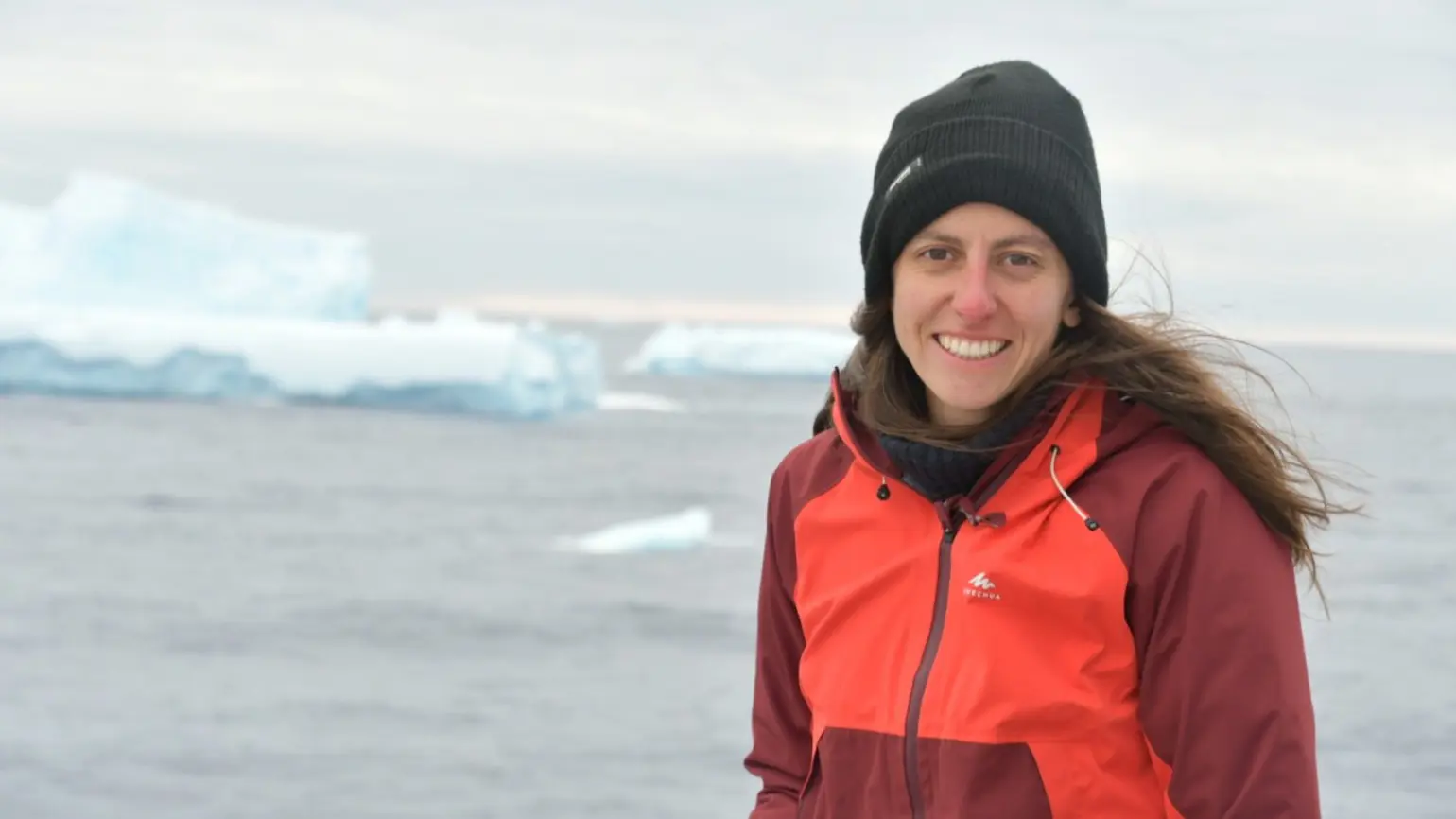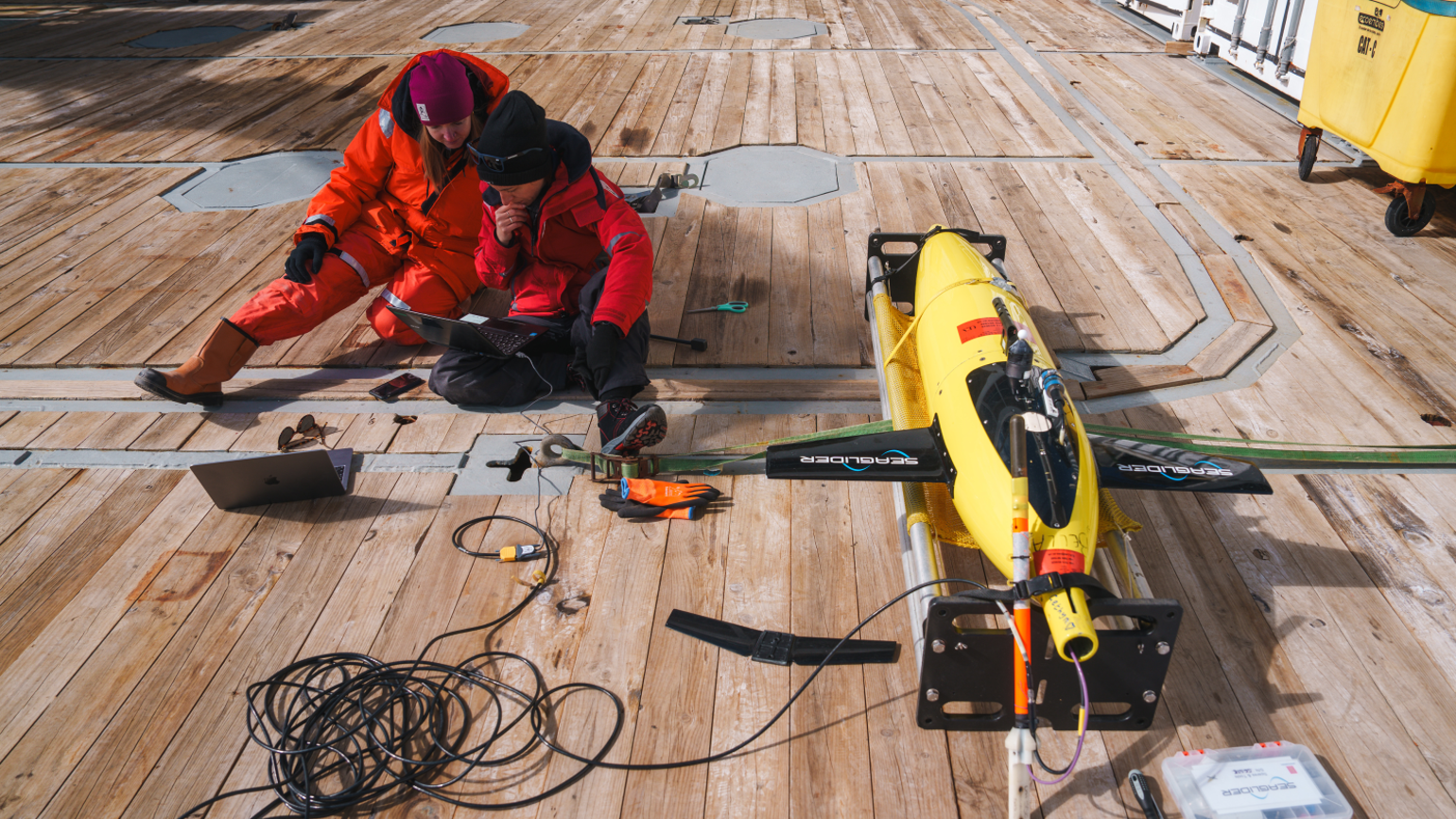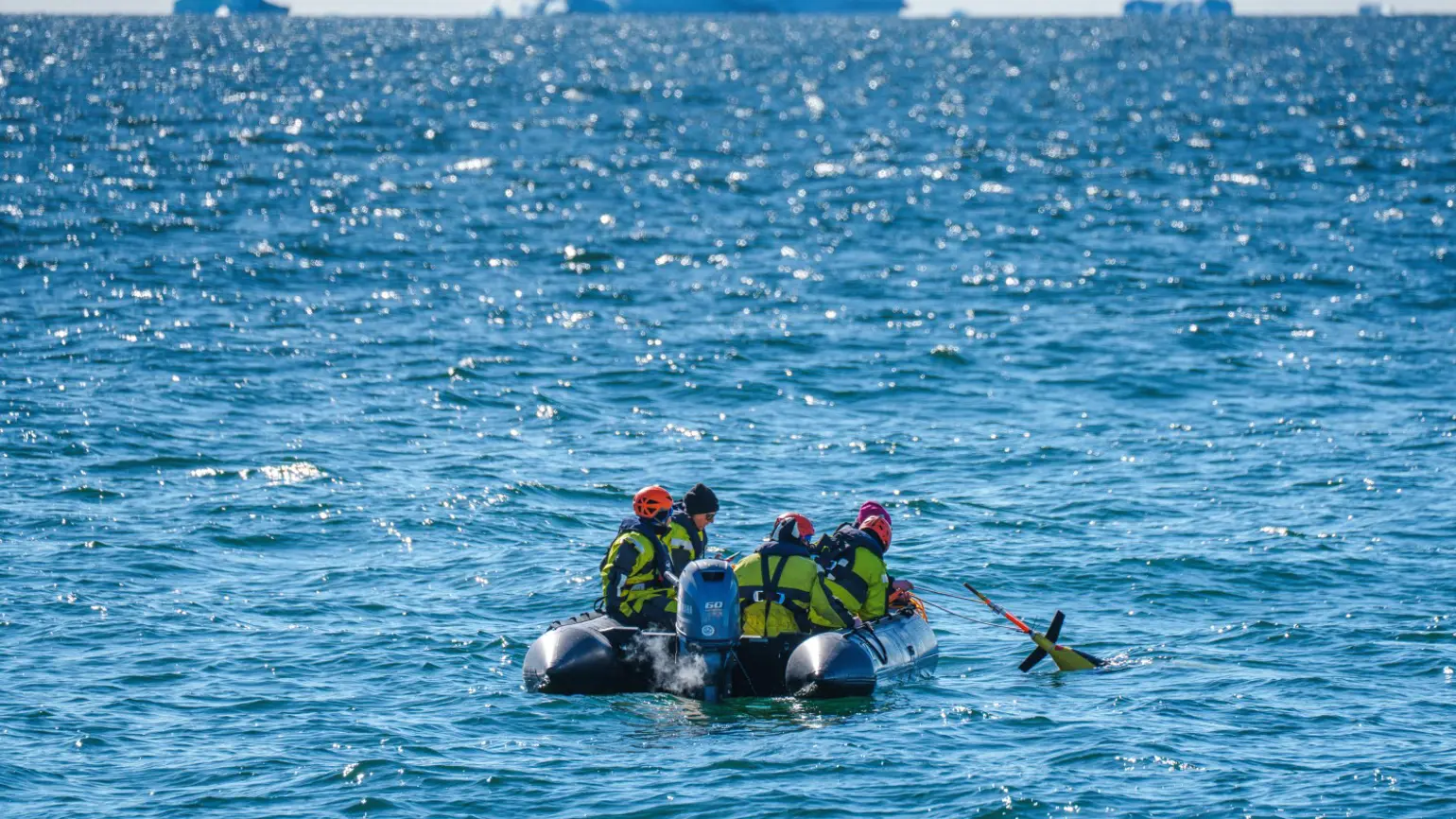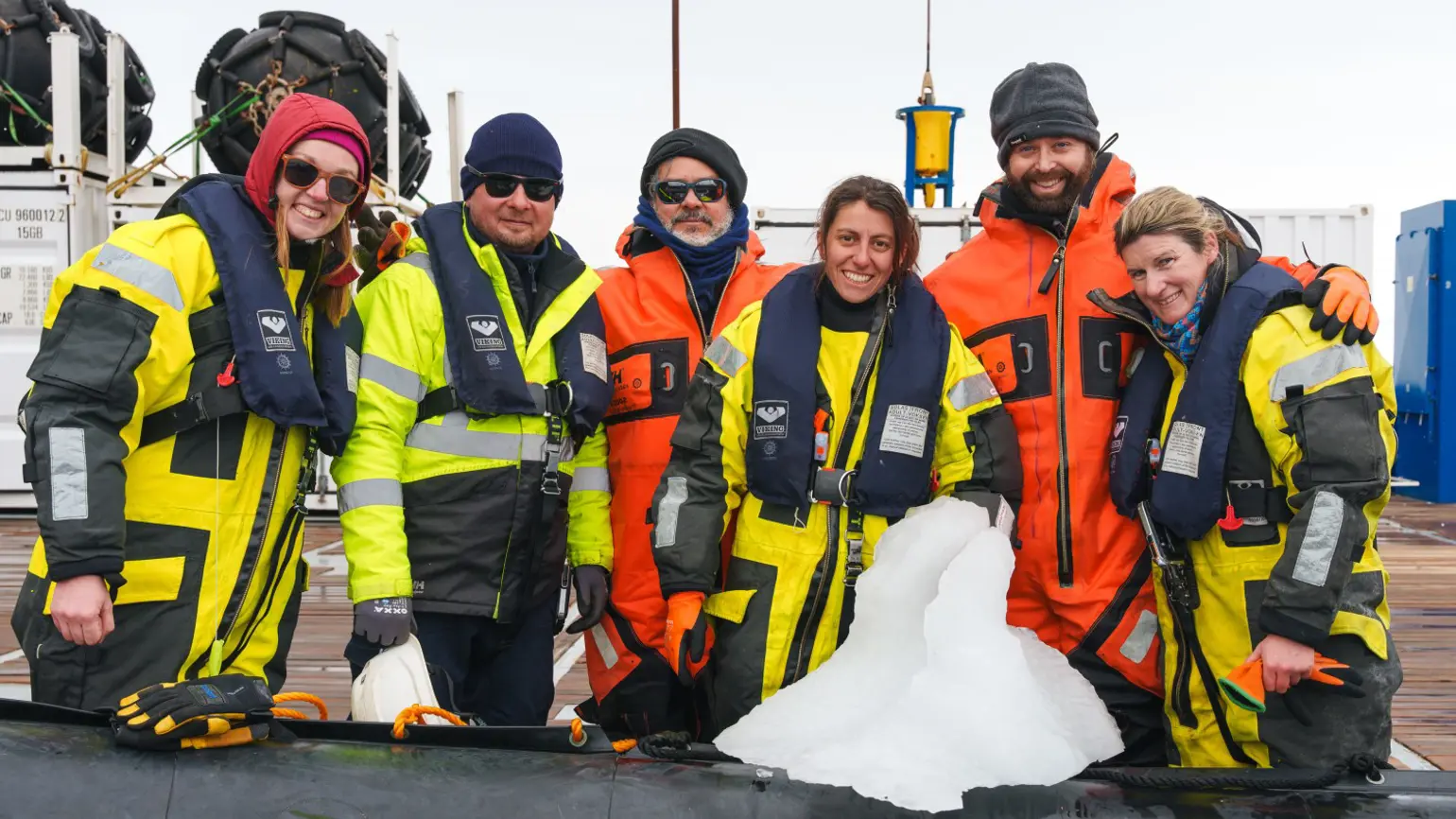11 June 2025
Understanding ocean currents in Antarctica
Outside of programmes, our Programme Directors award seed funding to individuals or teams pursuing ambitious research aligned with their opportunity space with the aim of challenging assumptions, opening up new research paths, and providing steps towards new capabilities.
Laura Cimoli – a seed Creator for Scoping Our Planet – and her team are setting out to better understand how glacial meltwater is exported from the Antarctic glacial margins to the open ocean – as well as the consequences of such processes for local ocean circulation and biogeochemistry. 
Laura Cimoli onboard the R/V Falkor (too).
Hi Laura! What are you currently working on?
"I study the physics of the ocean, which means I am interested in better understanding how ocean currents form and mix and how do they impact our climate. Ocean currents contribute to move heat, carbon, oxygen and nutrients around the globe, and so can affect local and global climate as well as biological productivity."
What research questions are you currently pursuing in Antarctica, and why can these questions only be answered there?
"West Antarctica has been melting at an alarming rate, and so the goal of our project is to better understand how the ocean circulation contributes to – and responds to – these changes. The accelerated melting in this region has been attributed to the intrusion of warm water onto the continental shelf, so one question is how this excess heat reaches the terminating glaciers. The increased melt leads to the formation of glacial meltwater, so another key question is what are the sources, rate and variability of this meltwater production and how does it change the local ocean stratification and circulation. And finally, we want to investigate whether meltwater could fuel primary productivity, by supplying nutrients (e.g. iron) that can limit photosynthesis in the Southern Ocean."
How do you get yourself, the team and your equipment to Antarctica?
"We shipped all the instruments to Punta Arenas, Chile, which is where we boarded the ship. From there, we started the journey down to Antarctica: it took us about 6 days to cross the Drake Passage - and we were lucky enough to find great weather conditions and (relatively) calm seas in one of the roughest oceans on the planet!"

Laura Cimoli (right) and Meredith Meyer (left) make the final communication checks before the deployment of an underwater glider in Antarctica. Photograph: Alex Ingle/Schmidt Ocean Institute.
Your research tackles one of the biggest challenges in climate science. What key uncertainties are you aiming to reduce – and how could your findings sharpen our climate projections?
"Climate models struggle to properly represent processes that happen very close to the ice, because a lot of them happen under the ice (in ice shelf cavities), where we lack observations, and they take place at a very small scale (or the order of few km, while most climate models have a resolution of ~100km). So, the data collected during this expedition will be very important in shedding light onto the ice-ocean interaction processes happening in this region, and informing us about how we could improve the representation of such processes in climate models."
What do you wish more people understood about Antarctica's role in global systems?
"Antarctica seems a remote, isolated place but really is not. From a climatic perspective, it plays a crucial role because the ocean that surrounds it, the Southern Ocean, is a nexus point connecting all ocean basins. So, processes around Antarctica really shape the global ocean circulation. As such, changes around Antarctica are not going to stay in Antarctica, but can have global impacts."

A team of scientists and crew members deploys an underwater glider in Antarctica. Photograph: Alex Ingle/Schmidt Ocean Institute.
Could you walk us through a typical day of conducting research in Antarctica?
"Research operations can be very intense because the ship operates 24/7 and you really want to get as much science out of every available minute. During this cruise, we were conducting a very multidisciplinary survey with all sorts of tools: ship-mounted, cabled, and autonomous. On top of that, we had to navigate through sea ice and glacial ice, so our navigation was partially constrained by the environmental conditions. So, a 'normal' day did not really exist because we had to be ready to conduct operations whenever it was needed. The chief scientists would coordinate operations with the bridge and the science party, so we would always have a 24h notice.
We deployed both cables and autonomous vehicles to maximise the data collection. While we were conducting surveys of the seafloor (e.g. mapping or visual surveys), the autonomous vehicles were being piloted by colleagues on land thanks to satellite communications. The deployments were done both from the ship as well as from a small boat. The small boat was used to deploy some autonomous vehicles in the water, and it was used because it gives us more control over the instrument manoeuvrability. While all operations are exciting, small-boat operations are more so because you are even more immersed into the surrounding environment – even if it means gearing up even more with full waterproof cold weather gear. For example, once we went on a venture to collect some sea ice to measure whether any phytoplankton was leaving in there. And once we had a Minke whale appearing just a few meters from the boat!"
What early findings or signals are emerging from your research so far?
"From the underwater glider deployments, we have clear signals of both the intrusion of warm Circumpolar Deep Water onto the continental shelf, which is the main cause of the accelerated melting rates in West Antarctica, and of the fresh meltwater. We are now quality-controlling the dataset before running more in-depth analysis that would allow us to quantify the volume, transport, and mixing of these different water masses. Beyond this, and as a total surprise, a 500 km2 iceberg calved from George VI, one of the ice sheets we were exploring. We are using the glider and float data to investigate the effect of this ~80m deep iceberg in stirring and mixing the upper ocean, with possible consequences for ocean stratification and biological productivity."

The glider deployment team is back onboard after a successful glider deployment. Photograph: Alex Ingle/Schmidt Ocean Institute.
